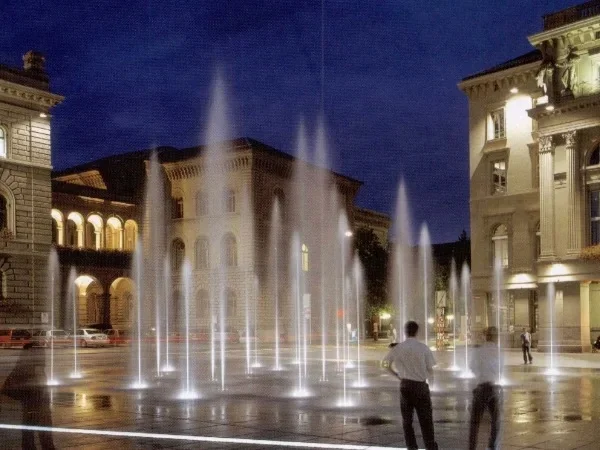Understanding Dry Fountain Design: A Comprehensive Guide to Modern Water Features
Dry fountains, also known as dry deck fountains, have emerged as a popular choice in contemporary landscape design. Unlike traditional fountains that continuously spray water, dry fountains feature nozzles and lights integrated into the ground, allowing for a stunning visual display without the presence of standing water. This design not only enhances aesthetic appeal but also provides a safe and interactive experience for pedestrians. At Ruibang, we specialize in innovative dry fountain designs that cater to various environments, including hotels, shopping malls, and public spaces. Here’s a comprehensive guide to understanding dry fountain design and its benefits.

1. What is a Dry Fountain?
A dry fountain is a type of water feature where the water jets are concealed beneath the surface until activated. When in operation, water sprays through openings in the ground, creating beautiful water columns or patterns while leaving the surrounding area dry and safe for foot traffic. This unique design allows for versatile use in high-traffic areas without obstructing movement or requiring additional space for water retention.
2. Key Components of Dry Fountain Design
The design of a dry fountain involves several critical components:
- Nozzles: These are strategically placed to create various water patterns and effects. The design can include multiple nozzle types to achieve different heights and shapes of water jets.
- Lighting: Integrated LED lights enhance the visual appeal of the fountain, especially at night. Color-changing lights can be programmed to create dynamic displays.
- Control Systems: Advanced control systems allow for automated operation of the fountain, including scheduling, water flow regulation, and lighting adjustments.
3. Benefits of Dry Fountains
Dry fountains offer numerous advantages:
- Space Efficiency: Since they do not require large basins or pools of water, dry fountains can be installed in compact areas where traditional fountains would not fit.
- Safety: With no standing water, dry fountains reduce the risk of slips and falls, making them ideal for public spaces frequented by children and families.
- Interactive Experience: These fountains invite interaction as visitors can walk right up to them, providing a playful environment where people can enjoy the beauty of water without the hazards associated with traditional fountains.
4. Design Considerations
When designing a dry fountain, several factors should be taken into account:
- Location: Choose a location that maximizes visibility and accessibility while considering foot traffic patterns.
- Water Source: Ensure there is an adequate supply of water and an efficient drainage system to handle overflow during heavy rains.
- Aesthetic Integration: The fountain should complement its surroundings, whether it’s in a park, plaza, or commercial space. Materials used should align with the overall design theme.
5. Maintenance Requirements
Maintaining a dry fountain involves regular inspections and cleaning to ensure optimal performance:
- Cleaning Nozzles: Regularly check and clean nozzles to prevent clogs from debris or mineral buildup.
- Water Quality Management: Implement filtration systems to maintain clean water within the fountain’s reservoir.
- Routine Inspections: Conduct periodic checks on pumps, lighting systems, and control mechanisms to ensure everything operates smoothly.
6. Innovative Trends in Dry Fountain Design
The field of dry fountain design is constantly evolving with new technologies and trends:
- Smart Technology Integration: Modern dry fountains can incorporate smart controls that allow users to adjust settings via smartphone apps or automated systems based on environmental conditions.
- Sustainable Practices: Many designs now focus on sustainability by utilizing rainwater harvesting systems or energy-efficient pumps.
Conclusion
Dry fountains represent a modern approach to water features that combine beauty with functionality. Their ability to enhance public spaces while providing safety and interactivity makes them an appealing choice for urban planners and landscape designers alike. At Ruibang, we are dedicated to creating innovative dry fountain designs that meet the needs of our clients while adding aesthetic value to their environments.
If you’re considering incorporating a dry fountain into your project or need expert advice on design options, contact us today! Let Ruibang help you create an extraordinary water feature that captivates visitors and enhances your space.
- Art
- Causes
- Crafts
- Dance
- Drinks
- Film
- Fitness
- Food
- Games
- Gardening
- Health
- Home
- Literature
- Music
- Networking
- Other
- Party
- Religion
- Shopping
- Sports
- Theater
- Wellness


